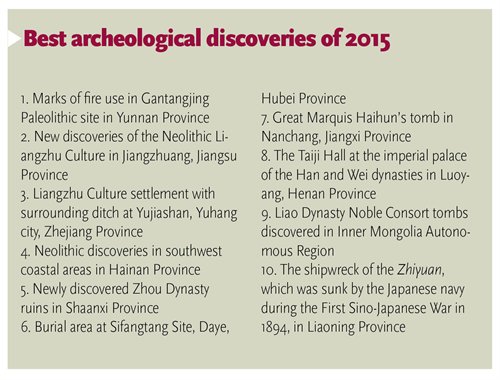
Han emperor's tomb, Qing warship on list
Chinese archaeologists on Monday named 10 ongoing excavations as the discoveries of the year, including a tomb belonging to a former emperor and a famous warship that sunk by Japanese navy.
During this year's archaeology forum in Beijing, which was dubbed "China's Archaeology Oscar," archeologists voted 10 out of 25 archeological discoveries the best discoveries of 2015, including the 2,000-year-old tomb of the Marquis of Haihun from the Western Han Dynasty (206BC-AD25) and the Chinese warship Zhiyuan from the Qing Dynasty (1644-1911) that was sunk by the Japanese navy during the First Sino-Japanese War (1894-95).
Among the 25 nominated discoveries, two were dated back to the Paleolithic Period and six were from the Neolithic Age, a significant increase from previous years.
Experts pointed out that 2015 was an especially fruitful year for archeology work and both the quantity and the quality of the discoveries show that China is conducting cutting-edge work, which will help the country become involved in archaeology elsewhere.
"Along with the recent booming development of China's archaeological work, the country's archaeological exploration will go outside, win approval from more countries, and promote cultural exchange and cooperation with them," said Liu Qingzhu, former head of the Chinese Academy of Social Sciences' (CASS) Institute of Archaeology.
The forum was held by the State Administration of Cultural Heritage and members from the administration's archaeology team, Chinese Archaeology Association and 76 institutions qualified to conduct excavation voted for the list.
Ancient tomb
Of the 10 discoveries, the tomb of the Marquis of Haihun is believed to possess particular significance as it is reportedly the best preserved tomb from the Western Han period ever found in China.
In December 2015, several ancient cauldrons were found in the tomb in Nanchang, Jiangxi Province, confirming the belief the tomb belonged to a deposed emperor from the Western Han Dynasty, the Xinhua News Agency reported.
Covering roughly 40,000 square meters and containing eight small tombs and a burial site for chariot horses, it is thought to belong to Liu He, grandson of Emperor Wu. Liu was given the title of the Marquis of Haihun after he was deposed as emperor after only 27 days. Haihun was the ancient name of a very small kingdom in the north of Jiangxi Province.
Excavation of the site started in 2011. Artifacts unearthed so far include a portrait of Confucius, nearly 3,000 wooden tablets and bamboo slips and a large number of bronze, gold and jade items.
Archaeologists have found a sword from the No. 5 tomb and assume it might have belonged to one of Liu's sons. Coffins from the No. 4 and No. 5 tombs have been hoisted and relocated for lab research.
Xu Changqing, head of the Jiangxi provincial institute of relics and archaeology, told the Global Times that the next step is to excavate the No.5 tomb to ascertain their relation to the marquis.
Liu said that excavation of the tomb of the Marquis of Haihun revealed many new findings and it renders important evidence into the funeral and metropolitan system of the West Han Dynasty.
Besides the tomb, another finding also came under the spotlight due to its political value.
After two years of recovery efforts, Chinese archaeologists in 2015 confirmed that the 2,300-ton warship, located underwater some 50 kilometers southwest of Dandong in Liaoning Province, was the battleship Zhiyuan, a protected cruiser built in England in 1885 and serving under the Imperial Beiyang Fleet that was destroyed when fighting the Japanese in the First Sino-Japanese War (1894-1895).
According to the official website of the CASS Institute of Archaeology, the ship was seriously damaged and all parts above the dome deck were lost.
There are burn marks on the cabin, prow, right shipboard and stern, and 60 types of artifacts were recovered during this survey, which include the ship units, weapons, personal items, and also more than 60 Qing coins.
The finding of Zhiyuan provides precious archaeological materials for the investigation of the history of Japanese aggression, said Liu.
Xu said that "archaeological studies aim to provide more valuable materials for the research of history, so that we could learn more cultural achievements to make the country better."


















































